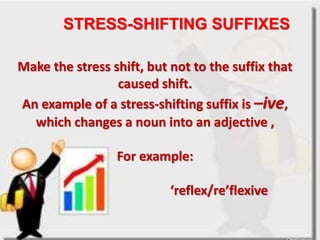English phonology
- 1. SUCI CHAIRUNISSA 201212501140 LIA NURJANAH 201212501170
- 4. IS SUPRASEGMENTAL FEATURE OF LANGUANGE THATâS IS OCCUR SIMULTANEOUSLY WITH SEGMENTS, THE CONSONANT AND VOWEL DESCRIBED IN PERCEDING CHAPTERS
- 6. CHARACTERISTICS OF âĒ LOUDER IN VOLUME âĒ LONGER IN DURATION âĒ HIGHER IN PITCH WHEN A SYLLABLE IS STRESSED, IT IS
- 7. LEVEL OF STRE ïUnstressed : having no recognizable amount of prominence. ïPrimary Stress (â) : stress which the most prominence ïSecondary stress (,) : stronger than unstressed but weaker than the
- 8. EXAMPLE OF WORD STRESS
- 12. DEFINITION DERIVATIONAL THE PROCESS OF FORMING A NEW WORD ON THE BASIS OF AN EXISTING WORD
- 13. SUFFIXES Is a group of letters placed at the end of a word to make a new word. A suffix can make a new word in one of two ways: âĒ Inflectional (grammatical) âĒ Derivational (the new word has a new meaning, "derived" from the original word)
- 14. DERIVATIONAL SUFFIXES, WHICH SOMETIMES AFFECT, ARE CLASSIFIED INTO THREE TYPES: 1.STRESS-PRESERVING 2.STRESS-ATTRACTING 3.STRESS-SHIFTING
- 15. STRESS-PRESERVING SUFFIXES produce change in stress placement in words. An example is the suffix âFul, which changes a noun into an adjectives, For example: âwonder/âwonderful. âbeauty/âbeautiful. âsuccess/âsuccessful.
- 16. Receive primary stress: for example, -ee, which changes a verb into a noun as in, STRESS-ATTRACTING S for example: ï emâploy/ employâee. ï reâfuge/refugâee
- 17. Make the stress shift, but not to the suffix that caused shift. An example of a stress-shifting suffix is âive, which changes a noun into an adjective , For example: âreflex/reâflexive STRESS-SHIFTING SUFFIXES
- 18. EXAMPLE WORD S SUFFI X AFTER ADDING SUFFIX âcomfo rt â-ableâ âcomfortableâ âwond er â-fulâ âwonderfulâ âamaz â-ingâ âamazingâ derivational suffixes do not affect the stress



















